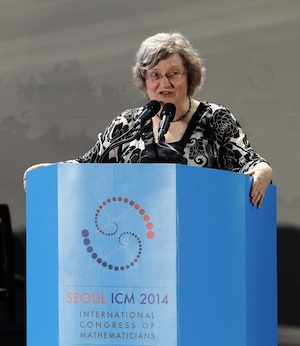
Happy International Women's Day 2015!

Maryam Mirzkhani, the first female Fields medallist
We may be a little late in celebrating International Women's Day but it's not for a shortage of excellent female mathematicians to celebrate! Here are some of the most inspiring women we've worked with or learnt about in the last year...
Maryam Mirzakhani is one of the best mathematicians in the world. Last August she received the Fields medal (one of the highest accolades in mathematics), recognised for her "rare combination of superb technical ability, bold ambition, far-reaching vision, and deep curiosity". She was the first woman to be awarded this prize and we were lucky enough to meet Mirzakhani and learn about her fascinating work in topology at the International Congress of Mathematicians (ICM) in Seoul last Summer.

Ingrid Daubechies at the opening ceremony of the International Congress of Mathematicians in 2014. Image copyright ⓒ 2010-2014 International Congress of Mathematicians 2014, all rights reserved.
At the ICM we were also fortunate to meet Ingrid Daubechies, President of the International Mathematical Union. As well as talking to her about the importance of a mathematical community, we heard her speak about her recent work virtually restoring paintings, just one application of wavelet theory. Famously it has also been used by the FBI to digitise finger prints, and it is widely used in medical imaging. Debauchies made fundamental discoveries in wavelet theory that opened up the field and has had an important role in making this mathematics into a practical tool for analysis in other areas outside mathematics. (You can read more about wavelets and how Debauchies work opened up this field here.)
We also found out about a fantastic mathematician, Margharita Piazolla Beloch, who discovered a new type of origami fold (the sixth axioms of origami) in 1936 and proved that this fold solves cubic equations. We'll write more about Beloch in upcoming articles, but it's thanks to her discovery that we can now solve the unsolvable and trisect an angle.
And finally, one of the people we've really enjoyed working with this last year (and years before that!) is Vicky Neale, our former colleague and now Whitehead Lecturer at the Mathematical Institute in Oxford. As well as learning many fascinating things working with Vicky on a project producing new and exciting resources for sixth form students, we've also really enjoyed listening to Vicky's contributions to many radio shows and her popular lectures and workshops. You can listen to many of her recordings online, the details are here.